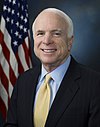John S. McCain Sr.
Last updatedJohn S. McCain Sr. | |
|---|---|
 | |
| Birth name | John Sidney McCain |
| Nickname(s) | Slew |
| Born | August 9, 1884 Carroll County, Mississippi, U.S. |
| Died | September 6, 1945 (aged 61) Coronado, California, U.S. |
| Place of burial | |
| Allegiance | |
| Service/ | |
| Years of service | 1906–1945 |
| Rank | |
| Commands held | |
| Battles/wars | World War I World War II |
| Awards | Navy Cross Navy Distinguished Service Medal (3) |
| Spouse(s) | Catherine Davey Vaulx |
| Relations | John S. McCain Jr. (son) John S. McCain III (grandson) |
John Sidney "Slew" McCain (August 9, 1884 – September 6, 1945) was a U.S. Navy admiral and the patriarch of the McCain military family. McCain held several command assignments during the Pacific campaign of World War II. He was a pioneer of aircraft carrier operations. [1] Serving in the Pacific Ocean theater of World War II, he commanded all land-based air operations in support of the Guadalcanal campaign, and in 1944–45, he aggressively led the Fast Carrier Task Force. His operations off the Philippines and Okinawa and air strikes against Formosa and the Japanese home islands caused tremendous destruction of Japanese naval and air forces in the closing period of the war. [2] He died four days after the formal Japanese surrender ceremony.
Contents
- Early life, education, and family
- Early career and World War I
- Interwar period
- World War II
- Death
- Family heritage
- Namesakes
- Awards
- Notes
- References
- Books
- External links
Several of McCain's descendants also graduated from the United States Naval Academy. He and his son, John S. McCain Jr., were the first father–son pair to achieve four-star admiral rank in the U.S. Navy during World War II. His grandson, John S. McCain III, was a prisoner of war during the Vietnam War. His great-grandsons, John S. McCain IV and James McCain, currently serve in the U.S. Navy and U.S. Marine Corps, respectively.
Early life, education, and family
John Sidney "Slew" McCain was born in Carroll County, Mississippi, the son and namesake of plantation owner [3] John Sidney McCain (1851–1934) and wife Elizabeth-Ann Young (1855–1922), who married in 1877. His grandparents were William Alexander McCain (1812–1864) and Mary Louisa McAllister, who were married in 1840. His great-grandmother, Mary Scales McCain, owned High Rock Farm, a plantation in Rockingham County, North Carolina. [4]
He attended the University of Mississippi for two years, where he joined the Phi Delta Theta Fraternity, and then decided to attend the United States Military Academy at West Point, where his brother William Alexander McCain was enrolled. [5] To practice for its entrance exams, he decided to take the ones for the United States Naval Academy; when he passed those and earned an appointment, he decided to attend there instead. [5] In doing so, he would leave behind his Mississippi plantation and adopt the Navy's itinerant life. [6]
At the Naval Academy, his performance was lackluster. [1] He failed his annual physical on account of defective hearing, but the condition was waived due to the great need for officers. [5] When he graduated in 1906, he ranked 79th out of 116 in his class, and the yearbook labeled him "The skeleton in the family closet of 1906." [1] His classmates included Arthur L. Bristol, William L. Calhoun, William A. Glassford, Charles C. Hartigan, Aubrey W. Fitch, Frank J. Fletcher, Robert L. Ghormley, Isaac C. Kidd, Leigh Noyes, Ferdinand L. Reichmuth, Raymond A. Spruance, John H. Towers, Russell Willson, and Thomas Withers.
He married Katherine Davey Vaulx (1876–1959), who was eight years his senior, on August 9, 1909, at Colorado Springs, Colorado.
Early career and World War I
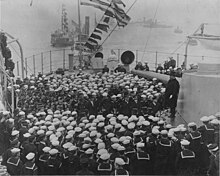
Soon after earning his commission, McCain sailed aboard the Great White Fleet's world cruise from 1907 to 1909, joining the battleship USS Connecticut for the last stretch home. [7] His next assignment was to the Asiatic Squadron, after which the Navy ordered him to the naval base at San Diego, California.
During 1914 and 1915 he was executive officer and engineering officer aboard the armored cruiser USS Colorado, patrolling off the Pacific coast of Mexico. [7] In September 1915, he joined the armored cruiser USS San Diego, flagship for the Pacific Fleet. [7]
After the U.S. entered World War I, McCain and San Diego served on convoy duty in the Atlantic, [7] escorting shipping through the first dangerous leg of their passages to Europe. Based out of Tompkinsville, New York, and Halifax, San Diego operated in the weather-torn, submarine-infested North Atlantic. McCain left San Diego in May 1918, two months before she was sunk, when he was assigned to the Bureau of Navigation. [7]
Interwar period

In the 1920s and early 1930s, McCain served aboard USS Maryland, USS New Mexico, and USS Nitro. His first command was USS Sirius. In 1935, McCain enrolled in flight training. Graduating at 52 in 1936, he became one of the oldest men to become a naval aviator [8] and from 1937 to 1939 he commanded the aircraft carrier USS Ranger. In January 1941, after promotion to rear admiral, he commanded the Aircraft Scouting Force of the Atlantic Fleet. [9]
Short in stature and of rather thin frame, McCain was gruff and very profane; he liked to drink and gamble. [6] He also showed courage and was regarded as a natural, inspirational leader. [6] In the words of one biographical profile, McCain "preferred contentious conflict to cozy compromise." [6]
World War II


After Japan attacked Pearl Harbor in December 1941, the Navy appointed McCain as Commander, Aircraft, South Pacific in May 1942. As COMAIRSOPAC, he commanded all land-based Allied air operations supporting the Guadalcanal campaign in the Solomon Islands and south Pacific area. Aircraft under McCain's command, including the Cactus Air Force at Henderson Field on Guadalcanal, were key in supporting the defense of Guadalcanal from Japanese efforts to retake the island during this time. [9]
In October 1942, the Navy ordered McCain to Washington, D.C., to head the Bureau of Aeronautics. In August 1943, he became Deputy Chief of Naval Operations for Air with the rank of vice admiral. [9]
McCain returned to combat in the Pacific in August 1944 with his appointment as commander of a carrier group in Marc Mitscher's Task Force 58 (TF 58), part of Raymond Spruance's Fifth Fleet. In this role, McCain participated in the Marianas campaign, including the Battle of the Philippine Sea, and the beginning of the Philippines campaign. [9] At the Battle of Leyte Gulf, Admiral William Halsey left in pursuit of a decoy force, leaving Rear Admiral Clifton "Ziggy" Sprague's Task Unit 77.4.3 (usually referred to by its radio callsign, "Taffy 3") to continue supporting forces ashore, defended by only a light screen of destroyers and destroyer escorts.
Taffy 3 came under attack from a much heavier Japanese force under Vice Admiral Takeo Kurita, provoking the Battle off Samar. Sprague promptly pleaded for assistance from Halsey, who was responsible for protecting the northern approach to the landing site. Halsey had contemplated detaching a battle group, Task Force 34 (TF 34), but chose to bring all available battle groups north to pursue the Japanese carrier force. Hearing Sprague's pleas (including messages in plain language, not even bothering to encrypt them as the situation grew desperate), Admiral Nimitz sent Halsey a terse message which was decoded as:
Where is, repeat, where is Task Force Thirty Four? The world wonders.
The final phrase, "The world wonders", was not intended to be part of Nimitz's message in whole; it was cryptographic security padding that had been added to the end of the actual message which should have been removed by the decrypter. This unfortunate inclusion infuriated Halsey, who then sent McCain's Task Group 38.1 (TG 38.1) to assist. [10]
McCain had been monitoring the original pleas for help and, recognizing the seriousness of the situation, turned around without awaiting orders.[ citation needed ] His ships raced downwind toward the battle, briefly turning into the wind to recover returning planes. At 10:30, a force of Curtiss SB2C Helldivers, Grumman TBF Avengers, and Grumman F6F Hellcats was launched from USS Hornet, USS Hancock, and USS Wasp at the extreme range of 330 miles (610 km). Though the attack did little damage, it strengthened Kurita's decision to retire. [11]
On October 30, 1944, McCain assumed command of Task Force 38 (TF 38). He retained command of the fast carrier task force that he led through the Battle of Okinawa and raids on the Japanese mainland. [9]
While conducting operations off the Philippines, McCain, as Chief of Staff of Third Fleet, participated in Halsey's decision to keep the combined naval task force on station rather than avoid a major storm, Typhoon Cobra (later known also as "Halsey's Typhoon"), which was approaching the area. The storm sank three destroyers and inflicted heavy damage on many other ships. Some 800 men were lost, in addition to 146 aircraft. A Navy court of inquiry found that Halsey committed an error of judgment in sailing into the typhoon, but did not recommend sanction. [12] McCain was ordered by the Navy Department on July 15 to hand over command of Task Force 38 to Admiral John H. Towers and, after a furlough, become deputy head of the Veterans Administration.
Death
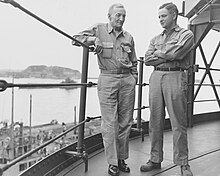
By war's end in August 1945, the stress of combat operations, lifelong anxiety, and probable heart disease had taken its toll on McCain. He requested home leave to recuperate, but Halsey insisted that he be present at the Japanese surrender ceremony in Tokyo Bay on September 2. Departing immediately after the ceremony, McCain died just four days later of a heart attack at his home in Coronado, California. [13] His death was front-page news, [1] [13] [14] . He was buried at Arlington National Cemetery. [15]
In 1949, McCain was posthumously promoted to full admiral (O-10) by a resolution of Congress. [16] This followed a recommendation of Secretary of the Navy Francis P. Matthews, who said that McCain's combat commendations would have earned him the promotion had he not died so soon after the war. [16] During his career, McCain was awarded the Distinguished Service Medal and two Gold Stars in lieu of subsequent awards. [17]
Family heritage
McCain's grandfather, William Alexander McCain (1817–1863) lived in Carrollton, Carroll County, Mississippi. During his life, he owned a 2,000-acre (8.1 km2) plantation there known alternately as "Teoc" (the Choctaw name for the creek it was located on) and "Waverly", as well as 52 slaves (some of whose descendants share the surname and call themselves the "black McCains"). [18] He was married in 1840 to Mary Louisa McAllister (1812–1882).
McCain's father, the elder John Sidney McCain, known as J. S. McCain, served as sheriff and, later, President of the Board of Supervisors of Carroll County.
McCain's older brother, another William Alexander McCain, also attended the University of Mississippi before transferring to the United States Military Academy. William A. McCain would eventually retire with the rank of brigadier general, and was awarded the Distinguished Service Medal for actions in World War I, as well as the Oak Leaf Cluster during World War II. An uncle, Henry Pinckney McCain (1861–1941), also attended West Point and later retired from the Army as a major-general. Camp McCain, a World War II training base and current Mississippi National Guard training site, located in Grenada County, Mississippi, was named for him.
McCain's son, John S. McCain Jr., was a submarine commander in World War II and later served as a Commander in Chief Pacific Command (CINCPAC) during the wars in Korea and Vietnam.
McCain's grandson, John S. McCain III, was a U.S. Navy captain during the Vietnam War; his life and military career was known for spending five years as a prisoner of war in the "Hanoi Hilton" and other North Vietnamese camps from 1967 to 1972. Following his retirement from the Navy, he served as both a Congressman and Senator from Arizona. He ran for President twice, in 2000 (losing the Republican nomination to George W. Bush) and in 2008, when he won the Republican Party's nomination but lost the general election to Barack Obama. His book Faith of My Fathers recounts his heritage and his experiences as a midshipman at Annapolis, a naval aviator and prisoner of war. Senator McCain's brother Joe McCain attended the US Navy Academy but served in the US Navy as an enlisted man.
John S. McCain III claimed a royal connection on his campaign website: "McCain's family roots in Europe are Scots-Irish. His great-aunt was a descendant of Robert the Bruce, an early Scottish king. McCain's roots in America date to the American Revolution. John Young, an early McCain ancestor, served on Gen. George Washington's staff." [19] John Young's ancestry has been traced to John Lamont, Baron McGorrie (the "red baron of Inverchaolain and Knockdow"; 1540–1583). [20] [21] According to DNA testing, Senator McCain was related through his mother to John Washington, a great-great-grandfather of President George Washington. [22]
Admiral McCain's great-grandson John Sidney "Jack" McCain IV attended and graduated from the U.S. Naval Academy in 2009 [23] and is a naval aviator. Jack McCain IV was awarded his diploma at Annapolis by President Obama, the man who defeated his father in 2008. Jack McCain IV is married to Capt. Renee Swift-McCain (USAF Reserve). Another great-grandson, James Hensley "Jimmy" McCain, enlisted in the Marine Corps in 2006. [24] He finished a tour of duty in the Iraq War in 2008. [25] Another, Douglas McCain, served as a Navy A-6E Intruder carrier pilot before turning to commercial aviation. [26]
Namesakes
McCain Field, the operations center at Naval Air Station Meridian, Mississippi, was named in his honor. [6]
The guided-missile destroyer USS John S. McCain (DL-3) (in service 1953–1978) was named for him, and the destroyer USS John S. McCain (DDG-56) (in service 1994–present) was named for Admiral John S. McCain Sr., Admiral John S. McCain Jr., and, as of a rededication ceremony 11 July 2018, Senator John S. McCain III.
McCain was a would-be author who wrote fiction that was never published, including some adventure stories under the name Casper Clubfoot. [27]
Awards
 | ||
| | ||
| | ||
| | ||
| | ||
| | ||
| Naval Aviator badge | |||||||||||||
| 1st Row | Navy Cross | Navy Distinguished Service Medal with two 5⁄16" Gold Stars | |||||||||||
|---|---|---|---|---|---|---|---|---|---|---|---|---|---|
| 2nd Row | Mexican Service Medal | World War I Victory Medal with "ESCORT" clasp | American Defense Service Medal with "FLEET" clasp | ||||||||||
| 3rd Row | American Campaign Medal | Asiatic-Pacific Campaign Medal with five 3/16 inch service stars | World War II Victory Medal | ||||||||||
| 4th Row | Navy Occupation Service Medal with "ASIA" clasp | Knight Commander, Order of the British Empire (Military Division) | Commander of the Order of the Sun of Peru | ||||||||||
| 5th Row | Peruvian Aviation Cross, 1st Class | Commander of the Order of Merit (Chile) | Philippine Liberation Medal with two stars | ||||||||||
Notes
- 1 2 3 4 Timberg, An American Odyssey, pp. 17–34.
- ↑ Alexander, Man of the People, pp. 13–14.
- ↑ McCain and Salter, Faith of My Fathers, p. 21.
- ↑ "Rockingham County historian Bob Carter combines discretion, scholarship". 16 October 2016.
- 1 2 3 McCain and Salter, Faith of My Fathers, pp. 22–23.
- 1 2 3 4 5 Leahy, Michael (2008-08-31). "A Turbulent Youth Under a Strong Father's Shadow". The Washington Post . Retrieved 2008-11-08.
- 1 2 3 4 5 Reynolds, Famous American Admirals, p. 206.
- ↑ His contemporary Admirial William Halsey also graduated at age 52 as a flight aviator.
- 1 2 3 4 5 Boatner, Biographical Dictionary, p. 351.
- ↑ McCain and Salter, Faith of My Fathers, 40–41.
- ↑ "Wasp". DANFS . U.S. Naval Historical Center. 2005-05-11. Retrieved 2008-09-04.
- ↑ Drury, Halsey's Typhoon.
- 1 2 "McCain dies suddenly at his home". Pittsburgh Post-Gazette. Associated Press. September 7, 1945. p. 1.
- ↑ "Admiral McCain dies". Milwaukee Sentinel. Associated Press. September 7, 1945. p. 1.
- ↑ "Burial detail: McCain, John S". ANC Explorer. Retrieved March 4, 2023.
- 1 2 "M'Cain Promotion Passed". Associated Press for The New York Times. 1949-08-28.
- ↑ USS John S. McCain (DDG 56), .
- ↑ Chideya, Farai (2008-10-21). "Black McCains Share Family's Struggles, Triumphs". NPR . Retrieved 2008-10-26.
- ↑ McCain and Salter, Faith of My Fathers, p. 19.
- ↑ "Ancestors of one Young family in America". Archived from the original on 2006-02-10. Retrieved 2007-07-05.
- ↑ Ancestry of John McCain (b. 1936)
- ↑ PBS Finding Your Roots broadcast February 9, 2016; he also has Native American ancestry.
- ↑ Superville, Darlene (2009-05-22). "Obama vows not to send people to war without cause". Yahoo! News . Associated Press. Archived from the original on May 25, 2009. Retrieved 2009-05-23.
- ↑ "Sen. McCain's youngest son joins Marine Corps". Marine Corps Times. Associated Press. July 31, 2006. Archived from the original on August 1, 2006. Retrieved 2006-08-01.
- ↑ "McCain win might stop sons from deploying". Navy Times. March 10, 2008. Retrieved 2008-03-17.
- ↑ Jennifer Steinhauer (2007-12-27). "Bridging 4 Decades, a Large, Close-Knit Brood". The New York Times. Retrieved 2007-12-27.
- ↑ Kirkpatrick, David D. (2008-10-12). "Writing Memoir, McCain Found a Narrative for Life". The New York Times . Retrieved 2008-10-13.
Related Research Articles

The United States Pacific Fleet (USPACFLT) is a theater-level component command of the United States Navy, located in the Pacific Ocean. It provides naval forces to the Indo-Pacific Command. Fleet headquarters is at Joint Base Pearl Harbor–Hickam, Hawaii, with large secondary facilities at Naval Air Station North Island, California.

The Battle of Leyte Gulf was the largest naval battle of World War II and by some criteria the largest naval battle in history, with over 200,000 naval personnel involved. It was fought in waters near the Philippine islands of Leyte, Samar, and Luzon from 23 to 26 October 1944 between combined American and Australian forces and the Imperial Japanese Navy (IJN), as part of the invasion of Leyte, which aimed to isolate Japan from the colonies that it had occupied in Southeast Asia, a vital source of industrial and oil supplies.

William Frederick "Bull" Halsey Jr. was an American Navy admiral during World War II. He is one of four officers to have attained the rank of five-star fleet admiral of the United States Navy, the others being William Leahy, Ernest King, and Chester W. Nimitz.

Raymond Ames Spruance was a United States Navy admiral during World War II. He commanded U.S. naval forces during the Battle of the Philippine Sea, one of the most significant naval battles of the Pacific Theatre. He also commanded Task Force 16 at the Battle of Midway, comprising the carriers Enterprise and Hornet. At Midway, dive bombers from Enterprise sank four larger carriers of the Imperial Japanese Navy. Most historians consider Midway the turning point of the Pacific War.

The Fast Carrier Task Force, was the main striking force of the United States Navy in the Pacific War from January 1944 through the end of the war in August 1945. The task force was made up of several separate task groups, each typically built around three to four aircraft carriers and their supporting vessels. The support vessels were screening destroyers, cruisers, and the newly built fast battleships.

The Battle of Rennell Island took place on 29–30 January 1943. It was the last major naval engagement between the United States Navy and the Imperial Japanese Navy during the Guadalcanal Campaign of World War II. It occurred in the South Pacific between Rennell Island and Guadalcanal in the southern Solomon Islands.

The United States Third Fleet is one of the numbered fleets in the United States Navy. Third Fleet's area of responsibility includes approximately fifty million square miles of the eastern and northern Pacific Ocean areas including the Bering Sea, Alaska, the Aleutian Islands, and a sector of the Arctic. Major oil and trade sea lines of communication within this area are critically important to the economic health of the United States and friendly nations throughout the Pacific Rim region.
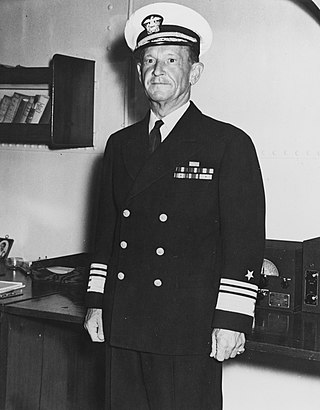
Frank Jack Fletcher was an admiral in the United States Navy during World War II. Fletcher commanded five different task forces through WWII; he was the operational task force commander at the pivotal battles of the Coral Sea and Midway, which collectively resulted in the sinking of five Japanese fleet carriers.

Vice Admiral Robert Lee Ghormley was an admiral in the United States Navy who served as Commander, South Pacific Area during World War II. Ghormley was long considered to be an ineffective leader–overly cautious, pessimistic, and even defeatist–but recent scholarship has shown that while he may not have been an inspiring leader, he performed well under difficult circumstances.
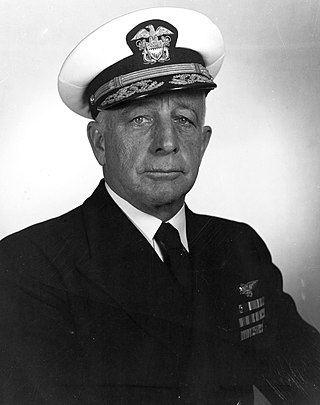
Aubrey Wray Fitch was an admiral of the United States Navy during World War II. A naval aviator, he held important aviation-related commands both at sea and on shore from the 1920s onward. He also served as superintendent of the United States Naval Academy.


Thomas Cassin Kinkaid was an admiral in the United States Navy, known for his service during World War II. He built a reputation as a "fighting admiral" in the aircraft carrier battles of 1942 and commanded the Allied forces in the Aleutian Islands Campaign. He was Commander Allied Naval Forces and the Seventh Fleet under General of the Army Douglas MacArthur in the Southwest Pacific Area, where he conducted numerous amphibious operations, and commanded an Allied fleet during the Battle of Leyte Gulf, the largest naval battle of World War II and the last naval battle between battleships in history.

USS Hull (DD-350) was a Farragut-class destroyer in the United States Navy during World War II. She was named for Isaac Hull.

Miles Rutherford Browning was an officer in the United States Navy in the Atlantic during World War I and in the Pacific during World War II. An early test pilot in the development of carrier-based Navy aircraft and a pioneer in the development of aircraft carrier combat operations concepts, he is noted for his aggressive aerial warfare tactics as a Navy captain on the Admiral's staff aboard USS Enterprise and at Nouméa during World War II. His citation for the Distinguished Service Medal states: "His judicious planning and brilliant execution was largely responsible for the rout of the enemy Japanese fleet in the Battle of Midway." Naval historian Craig Symonds disagrees, however, writing that "the citation claim that Browning was 'largely responsible' for the American victory at Midway, an assertion that some historians have taken seriously. .. is manifestly untrue."

USS Tabberer (DE-418) was a John C. Butler-class destroyer escort in service with the United States Navy from 1944 to 1945 and from 1951 to 1959. She was scrapped in 1973.
The Pacific War is a series of alternate history novels written by Newt Gingrich and William R. Forstchen with Albert S. Hanser. The series deals with the Pacific War between the United States of America and the Empire of Japan. The point of divergence is the decision of Admiral Isoroku Yamamoto, commander-in-chief of the Japanese Combined Fleet, to take personal command of the 1st Air Fleet for the attack on Pearl Harbor, rather than delegate it to Adm. Chūichi Nagumo.
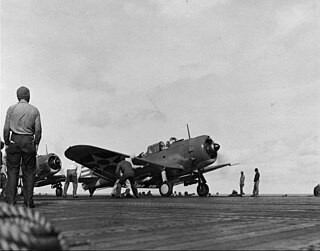
The Marshalls–Gilberts raids were tactical airstrikes and naval artillery attacks by United States Navy aircraft carrier and other warship forces against Imperial Japanese Navy (IJN) garrisons in the Marshall and Gilbert Islands on 1 February 1942. It was the first of six American raids against Japanese-held territories conducted in the first half of 1942 as part of the undertaken strategy.

John Howard Hoover was a United States Navy admiral who held several flag commands during World War II most notably those in the Central Pacific under Chester W. Nimitz. Hoover became one of Nimitz's trusted if little known admirals of the Pacific war.

During the last weeks of World War II, warships of the United States Navy, the Royal Navy and the Royal New Zealand Navy bombarded industrial and military facilities in Japan. Most of these bombardments were conducted by battleships and cruisers, and caused heavy damage to several of the targeted factories, as well as nearby civilian areas. A major goal of the attacks was to provoke the Japanese military into committing some of its reserve force of aircraft into battle. However, the Japanese did not attempt to attack the Allied bombardment forces, and none of the involved warships suffered any damage.
Naval historians such as Evan Mawdsley, Richard Overy, and Craig Symonds concluded that World War II's decisive victories on land could not have been won without decisive victories at sea. Naval battles to keep shipping lanes open for combatant's movement of troops, guns, ammunition, tanks, warships, aircraft, raw materials, and food largely determined the outcome of land battles. Without the Allied victory in keeping shipping lanes open during the Battle of the Atlantic, Britain could not have fed her people or withstood Axis offensives in Europe and North Africa. Without Britain's survival and without Allied shipments of food and industrial equipment to the Soviet Union, her military and economic power would likely not have rebounded in time for Russian soldiers to prevail at Stalingrad and Kursk.
References
Books
- Alexander, Paul (2002). Man of the People: The Life of John McCain. Hoboken, New Jersey: John Wiley & Sons. ISBN 0-471-22829-X.
- Boatner, Mark M. (1996). The Biographical Dictionary of World War II. Novato, California: Presidio Press. ISBN 0-89141-548-3.
- Robert Drury, Tom Clavin (2006). Halsey's Typhoon: The True Story of a Fighting Admiral, an Epic Storm, and an Untold Rescue. Atlantic Monthly Press. ISBN 0-87113-948-0.
- Gilbert, Alton (2006). A Leader Born: The Life of Admiral John Sidney McCain, Pacific Carrier Commander. Casemate. ISBN 1-932033-50-5.
- McCain, John; Salter, Mark (1999). Faith of My Fathers . New York: Random House. ISBN 0-375-50191-6.
- Reynolds, Clark G. (2002). Famous American Admirals. Naval Institute Press. ISBN 1-55750-006-1.
- Timberg, Robert (1999). John McCain: An American Odyssey . New York: Touchstone Books. ISBN 0-684-86794-X. Online access to Chapter 1 is available.
- Trimble, William F. Admiral John S. McCain and the Triumph of Naval Air Power Naval Institute Press, 2019) online review
This article incorporates text from the public domain Dictionary of American Naval Fighting Ships .
External links
- John Sidney McCain at arlingtoncemetery.net, an unofficial website
